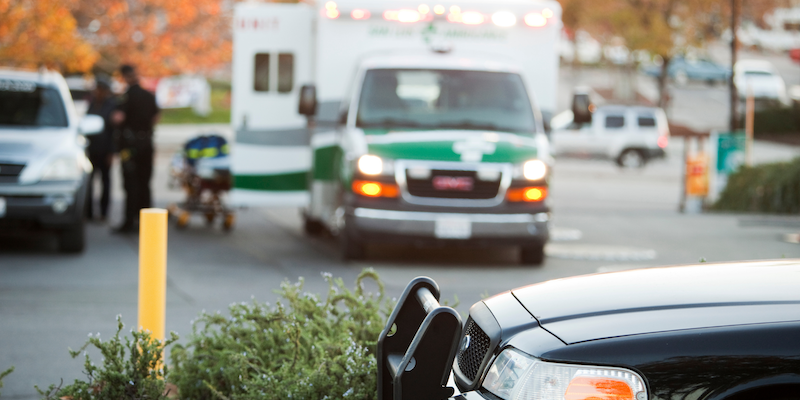By: Mark Turpin
When disaster strikes, every second counts. To ensure help arrives quickly and easily, there are a few steps your enterprise organization can take to make it easier for first responders to navigate your workplace and provide life-saving assistance as soon as possible.
Improving Your Emergency Response in Four Simple Steps
While a comprehensive solution like 9Line plays a vital role should disaster strike, it is only one piece of the puzzle. Even the best tools aren’t sufficient if you don’t have an emergency response plan in place.
Good Signs Save Lives
Investing in clear signage is critical. First responders aren’t going to be familiar with your workplace’s floorplan, so they will need to rely on signs to find their way. Whether you are upgrading your signs or just updating your information in the 911 system, make sure that the information in your 911 system reflects what is communicated on your signs.
Telling first responders that the call is originating from the 14th-floor breakroom isn’t very helpful if they get off the elevator and have no idea where the breakroom is. You can ensure they have the information they need by investing in a variety of signage. This may include:
- Hanging signs (particularly ones that include directional cues such as arrows)
- Posting each floor’s floorplan in the corresponding elevator bay
- Floorplans posted in hallways, lobbies, and other common, high-traffic areas
Many organizations are investing in digital signs, which can easily be updated should your floor plan change. Digital signs can also be programmed to tie into your 911 system, dynamically changing to guide first responders to the site of the emergency or help guide staff, customers, and other visitors to the exits should they need to evacuate the building.
To help ensure first responders have the information they need when disaster strikes, we offer 60 character location fields (compared to one competitor’s 19 characters) so you are never forced to truncate valuable directional and location information.
Design & Position Your Signs with Clarity in Mind
Signs are only useful if they are prominently displayed and offer useful, easy-to-digest information. Make sure you take the time to plan your signage, floorplan, and other critical cues carefully. Unless your emergency is happening in the lobby right in front of your main entrance, you are going to need to provide more granular information to guide first responders.
While floor numbers, suite numbers, and labels like “break room” are helpful, they don’t provide enough information. Time is of the essence in an emergency, so design your signs to provide as much information as possible in a clear, easy-to-digest format.
Know Your State Laws
Though federal laws like Kari’s Law and the Ray Baum Act apply to all jurisdictions within the United States, several states have their own laws governing emergency response measures enterprises need to have in place. These laws may be more or less stringent than their federal counterparts, so it is critical you understand what action is required on your part to ensure compliance.
For example, Illinois mandates that every 40,000 square feet be counted as a distinct location to make it easier for first responders to pinpoint the caller’s location.
As such, you can’t take a one-size-fits-all approach to 911 responses if your business operates in more than one jurisdiction.
States with additional 911 regulations include:
- Alaska
- Arkansas
- Colorado
- Connecticut
- Florida
- Illinois (additional information here and here)
- Kentucky
- Louisiana
- Maine (additional information here)
- Maryland
- Massachusetts
- Michigan
- Minnesota
- Mississippi
- New Hampshire (additional information here)
- New York
- Oklahoma (additional information here)
- Pennsylvania
- Tennessee
- Texas (additional information here, here, and here)
- Utah
- Vermont
- Virginia (chapter 15, sections 56-484.40, 21, 484.22, 484.23, and 484.25)
- Washington (additional information here)
Invest in Staff Training
If you are looking for assistance with employee training or other professional services, please let our team know, and we would be happy to connect you with one of our approved resellers in your area.
The American Red Cross offers group training programs aimed at businesses covering first aid, CPR, AED (defibrillator use), and BLS (basic life support) training.
You should also consider reviewing OSHA’s comprehensive guide on How to Plan for Workplace Emergencies and Evacuations.
First Aid & CPR
When a Kari’s Law notification comes through to your on-site staff, all employees need to understand what to do with that information and what they can do to help. Investing in first aid and CPR training for all on-site employees can help keep a bad situation from getting worse while you wait for first responders to arrive.
Purchase One or More Defibrillators
To improve employees’ first aid responses, you should consider purchasing one or more defibrillators, storing these life-saving devices in easy to locate places, and ensuring all on-site staff are trained to use them.
You should also make sure you are checking your defibrillators regularly to ensure they are still fit for service. How many defibrillators you should purchase will depend on the size of your workplace, so consider consulting with local health authorities or first responders to ensure you are fully prepared.
Create an After-Hours Plan
Sometimes circumstances require employees to work late, and for some team members like janitorial staff, the night shift is the norm. Make sure you have a plan in place for what to do if a 911 call is placed from your business after hours. This may include providing your security guards and janitorial staff with emergency response training (including first aid, CPR, and defibrillator use) or asking your 911 professional services provider for advice on how to proceed.
You should also have a plan in place for handling a situation where a remote worker places an after-hours 911 call using their company softphone.
Keep Your Papers in Order
From a legal liability standpoint, it pays to keep your papers in order. Make sure your team understands what sort of documentation needs to be produced and held onto should an emergency occur.
This documentation is critical from both a worker compensation and litigation standpoint, and what documentation is required may vary depending on what state you are in, so you should consult either your in-house legal team or a reputable lawyer for details.
Keep Your Wiring Closet Locked
One of the easiest things you can do to promote workplace safety is keep your wiring closet locked and limit access to trained team members only. When 9Line comes in completes your fully certified 911 deployment, we take an inventory of all of your landline phones and make sure they are mapped correctly in the 911 system.
When wires are moved around, the map is no longer accurate, which could cause your system to provide first responders with inaccurate location information, causing delays in a situation where every second counts.
Make sure everyone on your IT and facilities teams understands that when a cable in the wiring closet is moved, your 911 mapping software will need to be updated.
Why Choose 9Line?
Affordability
At 9Line, we believe that calling 911 is a right, not a privilege. That’s why we pride ourselves on offering affordable, easy to deploy enterprise 911 solutions. Some of our competitors charge as much as $5000 per month, as well as additional fees, regardless of how many employees you have or the size of your workplace.
To help ensure all organizations, regardless of size or budget, have the tools they need to keep their workers, visitors, and customers safe, we only charge $1 per user per month. No hidden fees. No unexpected costs.
CER Integration Makes 9Line Easy to Set Up; Easy to Use
9Line is proud to be a Cisco-approved solution partner. By partnering with Cisco, we make it easy to deploy and maintain your Cisco Emergency Responder (CER) compatible solution.
We’re Constantly Evolving to Serve You Better
To help serve you better, our team is constantly working on new innovations to help improve outcomes for 911 callers beyond simply providing address information.
We are currently in the process of adding support for additional platforms beyond Cisco in order to ensure all organizations have access to easy-to-use, affordable enterprise 911 solutions.
Our Friendly Experts are Always Here to Help
It’s always good to know that help is close at hand. Our friendly, fully trained customer success managers are always available to help, both during your deployment and for your entire subscription term.
When disaster strikes, it’s critical to have a plan in place as well as the tools you need to respond effectively. Don’t Delay. Book your free (virtual) assessment today.

